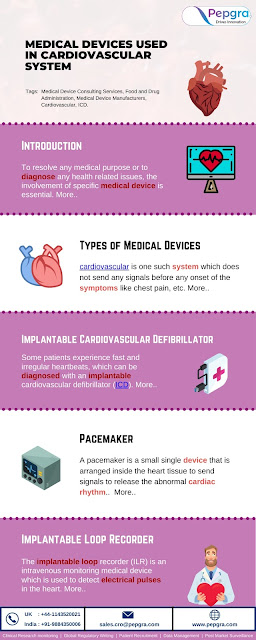Medical Devices used in Cardiovascular System | Pepgra
To resolve any medical purpose or to diagnose any health related issues, the involvement of specific Medical DeviceConsulting Services is essential.
However, for different usage purpose different medical devices are available which differentiates its significant role in specific diagnoses.Hence,medical device manufacturers manufacture specific medical devices to detect specific disease.
Similar to the drug approval, the design of medical device also gets approval from Food and Drug Administration (FDA). Every medical device has to undergo evaluation test as to check its risk factors. Mostly low risk medical devices reach the market without the FDA approval, medium risk medical devices have to undergo test demonstration of the device to prove its safety for patients and later gets approval from FDA and enters the market(Medicare Payment Advisor Commision, 2017).
The FDA defines medical devices as instruments which are used to diagnose various diseases, identifies the root cause of the disease, and treats the disease without the device getting absorbed into the patient’s body(FDA, 2020).
Usually the disease onset occurs with known reasons by alarming our body, but cardiovascular is one such system which does not send any signals before any onset of the symptoms like chest pain, cardiac arrest etc. Hence it is necessary to diagnose a person who visits diagnostic labs for a routine check-up prior to any damage to the cardiovascular system.There are various types of medical devices available in the diagnostic labs to treatdamage in the cardiovascular system such as implantable cardiovascular defibrillator (ICD), pacemaker, biventricular pacemaker, and implantable cardiac loop recorder.
Some patients experience fast and irregular heartbeats, which can be diagnosed with an implantable cardiovascular defibrillator (ICD), a cardiac medical device.This device detects if the blood pumping process has stopped in the lower chambers of heart ventricles. If not diagnosed properly this might lead to heart attack in future. For such patients ICD along with biventricular pacemaker is implanted inside the patient’s body under the collarbone which when senses abnormal heart rate, it automatically sends electrical pulses internally to the heart and blows back the heart’s rhythm to normal condition.
This device even has a memory card attached, which would record the number of times it has released electric shocks to heart. Moreover, some ICDs are manufactured along with pacemaker in order to deliver signals when heart functioning is weakso that it can soonstabilize after receiving the electric pulses(Langone, 2020).
Another medical device is a pacemaker which is a small single device that is arranged inside the heart tissue to send signals to release the abnormal cardiac rhythm seen inbradycardiato normalize pulse rate. This device is powered by battery, when the natural pacemaker of heart fails to beat normally, the artificial pacemaker mimics as natural pacemaker and executes heart’s normal function(Association, 2020).Another pacemaker is known as biventricular pacemaker, placed on both the sides at right and left ventricles of heart.
This type of pacemaker manages to treat heart failure called as cardiac resynchronization or cardiac resynchronization therapy. This kind of therapy is useful in patients suffering with heart failure and uncoordinated activation of the heart muscle.Thepacing is done to both the lower heart chambers by contracting and re-coordinating of heart muscles which parallely initiates the heart beat immediately. This helps in reduction of short breaths, which simultaneously improve the symptoms and also enhances the lifespan of the patient.
On the other hand, some types of biventricular pacing devices pumps shocks to the heart are known as biventricular defibrillators and perform its function similar to ICDs. When a patient experience fast rhythm problem, this devicedetects the abnormal heartbeat and soon delivers the electric shocksignals tothe bottom chamber of theheart to normalize the heartbeat.
Heart failures like cardiomyopathy develops due to weak and stretched heart muscles explains the severity of heart beat, and for such problems electrical system functions with every beat of the heart effectively. However, heart failure patients sometimes experience trouble even though peacemaker is installed. In this case the heart electrical system does not pass on the electrical signals to reach both sides of the heart equally.
When such a lag occurs, the electric signal passage is slowed, and some sections of the heart muscles stop its beat which is known as dyssynchrony.However, the main aim of these biventricular defibrillators is to increase the activity of all the muscles in the heart to give the beat at the same time. Hence thereby, biventricular pacing gives a coordinated pumping action ofthe heart called as resynchronization action(Wexner Medical, 2020).
The implantable loop recorder (ILR) is an intravenous monitoring medical device which is used to detect electrical pulses in the heart for a long period of time when compared with the constant electrical activity found in the ECGs(Santini et al., 2018).
It helps in identifying the specific reason why there is a palpitation, assessing bradycardia episodes before implanting a permanent pacemaker, and it checks the average heart rate in atrial fibrillation and so on(Bisignani et al., 2019). Hence, this practice is a novel chance forphysiciansto check the systematic heart rhythm screening with possible effects on patients undergoing antiarrhythmic and anticoagulant therapy management. However, still advanced research has to be granted to recognize the capability of these medical devices(Bisignani et al., 2019).
To Read More :
Clinical research organization services
Medical Device Consulting Services
Medical device
clinical Consulting
FDA
Consulting for Medical Device




Thank you for posting. It is a very informative blog. Keep posting.
ReplyDeletehealthcare regulatory documents
medical regulatory documents